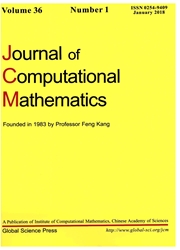

 中文摘要:
中文摘要:
实际兴趣的许多问题的几何学从圆形或椭圆形的弧被创造。弧边界元素能确切代表这些边界,并且因而,错误由表示用多项式形状功能的如此的几何学能被移开引起。为了充分利用圆形的边界,非退化的边界积分方程(BIEs ) 和一个将军的几何学,为弧元素可得到的非线性的转变技术被介绍外面移开或抑制不可分的核的单个或将近单个的性质。几个基准 2D elastostatic 问题证明现在的算法罐头有效地处理为边界层效果和薄墙的结构的问题发生在边界元素方法(BEM ) 的单个、将近单个的积分。由于准确几何表示的雇用,没有增加另外的更计算的努力,仅仅沿着边界和高精确性要划分的元素需要的一个小数字能被完成。[从作者抽象]
 英文摘要:
英文摘要:
The geometries of many problems of practical interest are created from circular or ellip- tic arcs. Arc boundary elements can represent these boundaries exactly, and consequently, errors caused by representing such geometries using polynomial shape functions can be removed. To fully utilize the geometry of circular boundary, the non-singular boundary integral equations (BIEs) and a general nonlinear transformation technique available for arc elements are introduced to remove or damp out the singular or nearly singular proper- ties of the integral kernels. Several benchmark 2D elastostatic problems demonstrate that the present algorithm can effectively handle singular and nearly singular integrals occur- ring in the boundary element method (BEM) for boundary layer effect and thin-walled structural problems. Owing to the employment of exact geometrical representation, only a small number of elements need to be divided along the boundary and high accuracy can be achieved without increasing other more computational efforts.
 同期刊论文项目
同期刊论文项目
 同项目期刊论文
同项目期刊论文
 期刊信息
期刊信息
